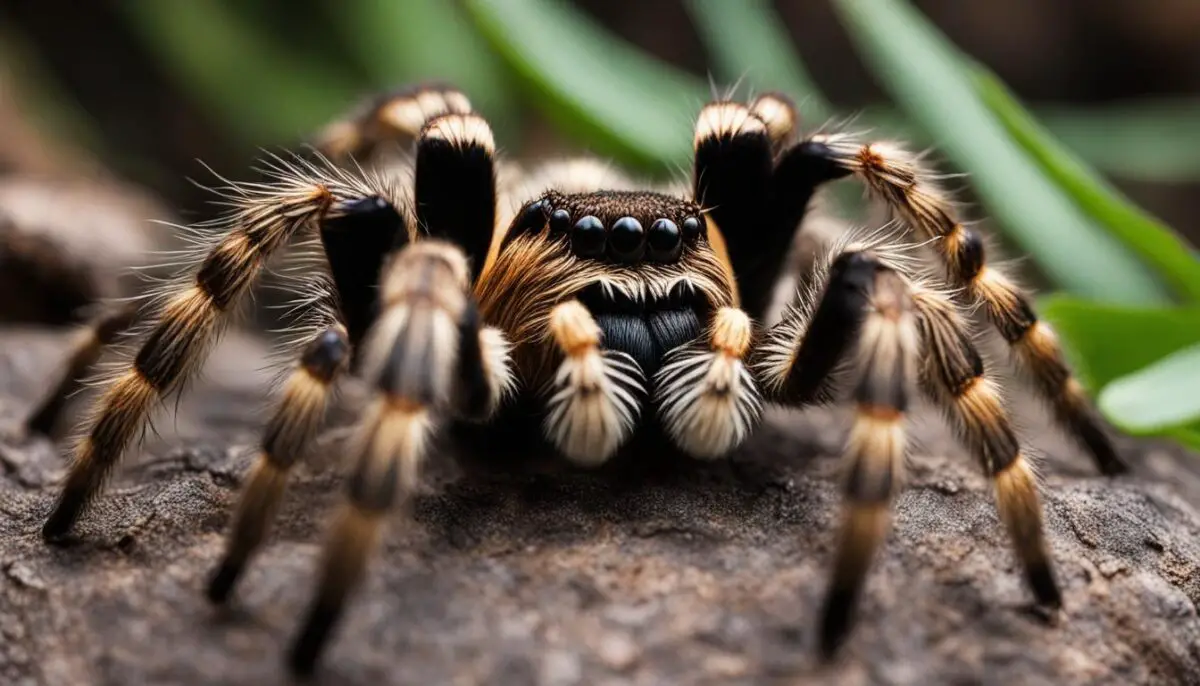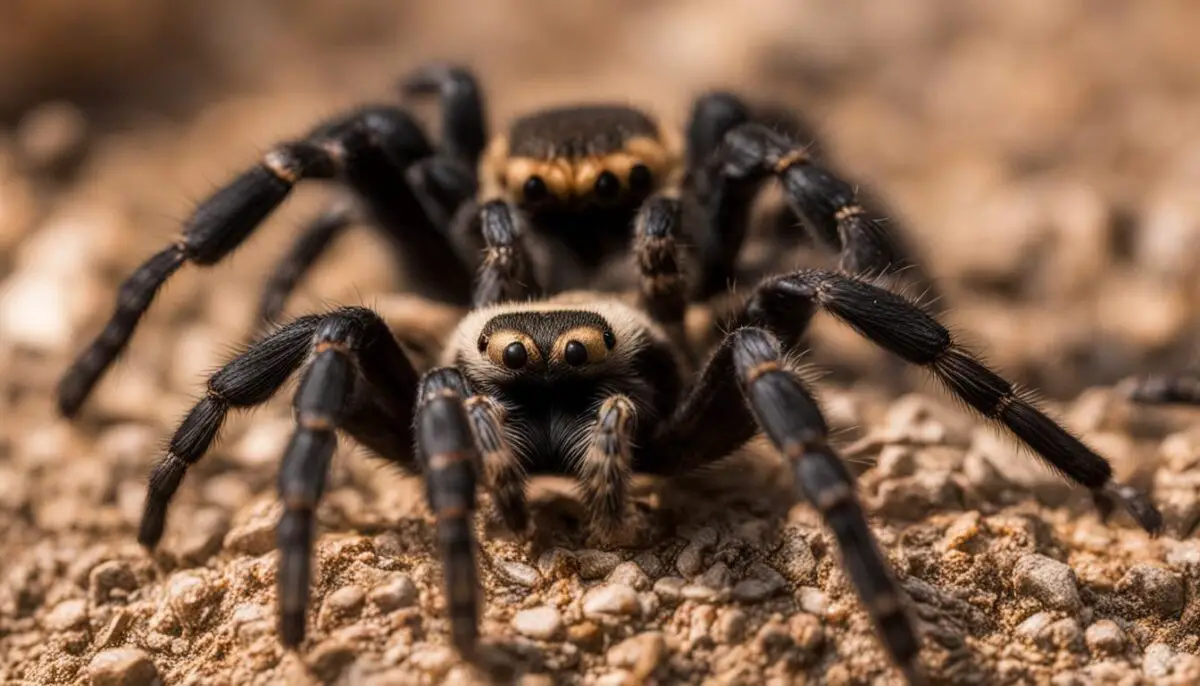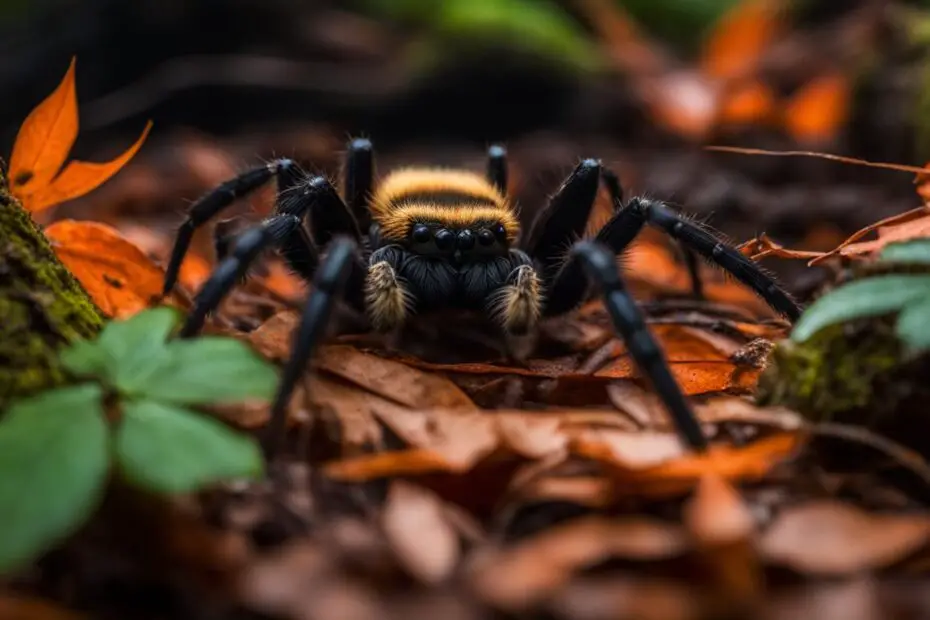When it comes to tarantulas, their fearsome appearance often leads to questions about their toxicity and potential harm to humans. In this article, we will explore the truth behind tarantula venom, toxicity levels, and the actual risks associated with their bites.
Despite their reputation, tarantulas are generally not poisonous to humans. While they do possess venom, it is typically harmless and not lethal. In most cases, their bites may cause localized pain, swelling, or redness, but these symptoms are usually mild and subside within a few hours. It is essential to note that individual reactions can vary, and severe symptoms are rare. Let’s delve deeper into what makes tarantulas venomous and how it affects humans.
Are Tarantulas Poisonous
The Venom and Fangs of Tarantulas
Tarantulas, like many other spiders, possess venom that they use to subdue their prey. However, the venom of tarantulas is generally not lethal to humans. Tarantulas have relatively small fangs that are less capable of penetrating human skin compared to other venomous spiders. Therefore, tarantula bites on humans usually result in mild symptoms such as localized pain, numbness, and swelling. Severe reactions or allergies to tarantula bites are rare.
While tarantulas do have venom, it is important to note that their bites are not considered dangerous to humans. The venom stored in their fangs and glands is primarily used to immobilize their prey, such as insects and small creatures. Tarantulas are not aggressive towards humans and will usually only bite in self-defense. They rely on their large webs and quick movements to escape threats rather than engaging in direct confrontation. are tarantulas poisonous
In summary, tarantulas have venom and fangs, but their bites are generally not a cause for concern in terms of human health. Their venom is not highly toxic, and their bites typically result in mild symptoms that subside within a few hours. Tarantulas primarily use their venom for catching prey and self-defense rather than causing harm to humans.
Symptoms and Treatment of Tarantula Bites
When bitten by a tarantula, it is important to understand the symptoms and proper treatment. The most common symptoms of a tarantula bite include localized pain, numbness, and swelling. While these symptoms can be uncomfortable, they are usually mild and subside within a few hours. It is crucial to remember that individual reactions to tarantula bites may vary, and in rare cases, some people may experience more severe symptoms. poisonous tarantulas
To effectively treat a tarantula bite, the first step is to clean the bite area with soap and water. This helps prevent infection and promotes healing. Applying a cold compress to the affected area can also help reduce swelling and alleviate discomfort. In most cases, no further medical attention is required, as tarantula bites are not considered to be a significant health risk to humans. are all tarantulas poisonous
| Symptoms of Tarantula Bites | Treatment |
|---|---|
| Localized pain | Clean the bite area with soap and water |
| Numbness | Apply a cold compress to reduce swelling |
| Swelling | Monitor symptoms and seek medical attention if severe |
However, it is crucial to seek medical help if you experience severe symptoms or an allergic reaction to a tarantula bite. While these cases are rare, if you have difficulty breathing, experience chest pain, or develop a rash or hives, it is important to consult a healthcare professional for proper evaluation and treatment.
Types of Tarantulas and their Poisonous Level
Tarantulas are a diverse group of spiders, with over 900 identified species worldwide. While all tarantulas possess venom, the level of toxicity can vary among different species. It is important to note that not all tarantulas are considered to be poisonous or highly venomous. In fact, the majority of tarantula bites are relatively harmless to humans. dangerous tarantulas
To provide a better understanding, below is a table summarizing the toxicity levels of some notable tarantula species:
| Tarantula Species | Toxicity Level |
|---|---|
| Goliath Birdeater | Low |
| Brazilian Black Tarantula | Moderate |
| Greenbottle Blue Tarantula | Low |
| Venezuelan Suntiger | Low |
| Indian Ornamental Tarantula | Moderate |
As seen in the table, the majority of tarantulas have a low toxicity level. However, there are some species, such as the Brazilian Black Tarantula and the Indian Ornamental Tarantula, that have a moderate toxicity level. It’s important to note that even with moderate toxicity, tarantula bites are rarely life-threatening to humans. dangers of tarantula bites
It’s worth mentioning that individual reactions to tarantula bites may vary, and some people may experience more severe symptoms or allergic reactions. In such cases, seeking medical attention is advisable. However, the overall health risks associated with tarantula bites remain relatively low.
Tarantula Behavior and Self-Defense
Tarantulas are fascinating creatures known for their unique behavior and self-defense mechanisms. Despite their intimidating appearance, they are generally not aggressive towards humans and prefer to escape from threats rather than attack. These remarkable arachnids use their large webs and their ability to move quickly to create a barrier between themselves and potential danger. health risks of tarantulas
In their natural habitat, tarantulas are skilled at camouflage and blending in with their surroundings. They often hide in burrows or use natural crevices as their homes, providing them with a safe space to retreat to. When they sense a potential threat, they may use their urticating hairs as a defense mechanism. These hairs, found on their abdomen, can be released by rubbing their legs against their body, causing irritation and discomfort when they come into contact with the predator’s skin or eyes.
While tarantulas rarely bite humans, they do have the capability to deliver a bite as a last resort in self-defense. It is important to note that their bites are not considered dangerous or venomous to humans, and the main health risks associated with tarantulas are more related to allergies or severe reactions in certain individuals. Understanding tarantula behavior and respecting their space can help minimize any potential interactions and foster coexistence between humans and these incredible creatures. tarantula toxicity level
Characteristics of Tarantula Self-Defense
- Tarantulas prefer to escape threats rather than attack
- They use their large webs and speed to create a barrier between themselves and danger
- They have urticating hairs that can cause irritation and discomfort to predators
- Tarantulas rarely bite humans, and their bites are not considered dangerous
- Health risks associated with tarantulas are more related to allergies or severe reactions in certain individuals
| Behavior | Defense Mechanism |
|---|---|
| Escaping threats | Using large webs and speed to create a barrier |
| Camouflaging and hiding | Releasing urticating hairs for irritation and discomfort |
| Rarely biting humans | Bites are not considered dangerous or venomous |
Overall, tarantulas are not considered dangerous or aggressive towards humans. Their self-defense mechanisms are mainly focused on escaping threats and using their unique adaptations to deter predators. By understanding and respecting their behavior, we can appreciate the vital role they play in our ecosystems and coexist peacefully with these remarkable arachnids. tarantula bite symptoms

Identification and Habitat of Tarantulas
Tarantulas are fascinating creatures that come in various species, each with its own unique characteristics. One notable feature is their size, with females typically being larger than males. They can range from a few inches to several inches in leg span, making them quite impressive to observe. In terms of appearance, tarantulas can vary in color and pattern, allowing for easy identification.
When it comes to their habitat, tarantulas can be found in diverse environments around the world. They can be seen in deserts, forests, grasslands, and even rainforests. These arachnids usually create burrows, using their legs and fangs to dig holes or utilize natural crevices as their homes. It’s interesting to note that tarantulas are primarily nocturnal creatures, meaning they are most active during the night when they hunt for prey.
Table: Comparison of Tarantula Species
| Tarantula Species | Size (Leg Span) | Color | Habitat |
|---|---|---|---|
| Chilean Rose Tarantula | 4-5 inches | Reddish-brown | Deserts and scrublands of Chile |
| Goliath Birdeater | 10-12 inches | Brown or black | Amazon rainforest |
| Pinktoe Tarantula | 3-4 inches | Pink or purple | South American rainforests |
| Mexican Redknee Tarantula | 5-6 inches | Black with red knees | Mexican deserts |
As shown in the table above, different species of tarantulas exhibit varying sizes, colors, and habitats. This diversity adds to the intrigue and wonder surrounding these creatures. Whether it’s the vibrant pinktoe tarantula of South American rainforests or the impressive Goliath birdeater found in the Amazon, each tarantula species contributes to the intricate tapestry of the natural world.
Overall, understanding the identification and habitat of tarantulas provides valuable insights into their behavior and adaptations. These remarkable creatures have adapted to thrive in different environments, showcasing their remarkable resilience and ability to coexist with other species.
The Diet and Prey of Tarantulas
Tarantulas have a carnivorous diet and primarily feed on insects and other small creatures. They are efficient predators and play a crucial role in controlling insect populations in their habitats. Some common prey items for tarantulas include crickets, grasshoppers, beetles, and other spiders. While tarantulas are capable of inflicting bites on their prey to immobilize them, their bites are not considered dangerous to humans.
The main health risks associated with tarantulas are more related to allergies or severe reactions in certain individuals rather than the toxicity of their venom. It is important to note that individual reactions to tarantula bites may vary, and in rare cases, some people may experience more severe symptoms. However, the overall health risks associated with tarantula bites are low, and they are not considered to be a significant danger to humans.
Table:
| Tarantula Diet | Prey |
|---|---|
| Insects | Crickets, grasshoppers, beetles |
| Other Spiders | Webs and smaller spider species |
| Small Creatures | Snails, small lizards, small mammals |
Tarantulas are fascinating creatures with unique hunting techniques. They use their large webs to ensnare prey or actively hunt them down. Once caught, tarantulas inject their venom into the prey to immobilize them and then proceed to feed on their captured meal.
In summary, tarantulas have a diverse diet consisting of insects, other spiders, and small creatures. While their bites are not dangerous to humans, it is important to exercise caution and seek medical attention if severe symptoms or an allergic reaction occur.
Reproduction and Life Cycle of Tarantulas
Understanding the reproduction and life cycle of tarantulas provides insight into the fascinating world of these arachnids. Tarantulas reproduce through sexual reproduction, with males engaging in unique mating rituals to attract females. These rituals often involve intricate dances or vibrations that communicate their intentions. Once a male successfully courted a female, he deposits a sperm packet on the ground, picks it up with his pedipalps, and inserts it into the female’s reproductive opening.
After mating, the female tarantula will lay eggs in silk egg sacs that she creates. The number of eggs can range from a few dozen to a few hundred, depending on the species. The female guards the egg sac, protecting it until the spiderlings hatch. This protective behavior ensures the survival of the offspring.
Once the spiderlings emerge from the egg sac, they undergo several molts or shed their exoskeletons to grow. With each molt, they increase in size and develop more adult-like characteristics. The exact duration of the life cycle varies depending on the species and environmental factors. In some cases, it can take several years for a tarantula to reach maturity.

Life Cycle of a Tarantula
| Stage | Description |
|---|---|
| Egg | The female tarantula lays eggs in a silk egg sac. |
| Spiderling | After hatching from the egg sac, the spiderlings resemble miniature versions of adult tarantulas. |
| Juvenile | As the spiderlings grow, they molt several times, shedding their exoskeletons and developing adult-like characteristics. |
| Adult | Once the tarantula reaches maturity, it is considered an adult and is capable of reproducing. |
The life cycle of a tarantula is an intriguing process that highlights the resilience and adaptability of these creatures. By understanding their reproductive habits and life stages, we can gain a deeper appreciation for the unique nature of tarantulas.
Conclusion
After unraveling the truth about tarantulas, it is clear that these creatures are generally not poisonous or highly dangerous to humans. While they do possess venom, their bites typically cause mild symptoms such as localized pain, swelling, or redness, which usually subside within a few hours. Tarantulas are beneficial predators that help control insect populations and are not aggressive towards humans.
Understanding tarantula behavior and knowing how to respond to a tarantula bite is essential for fostering coexistence and appreciation for these fascinating arachnids. While tarantulas may appear intimidating, their bites are more of a minor inconvenience than a serious health risk. The dangers associated with tarantula bites are primarily related to allergies or severe reactions in certain individuals rather than the toxicity of their venom.
So, the next time you come across a tarantula, there’s no need to panic. Remember that they play an important role in nature and are generally harmless to humans. If you happen to get bitten, follow the recommended treatment of cleaning the bite area with soap and water and applying a cold compress to reduce swelling. Seek medical help only if you experience severe symptoms or an allergic reaction.
FAQ
Are tarantulas poisonous to humans?
Tarantulas, despite their intimidating appearance, are generally not poisonous to humans. While they do possess venom, it is typically harmless and not lethal to humans.
What are the symptoms of a tarantula bite?
Symptoms of a tarantula bite may include localized pain, swelling, and redness. However, these symptoms are usually mild and subside within a few hours.
How should I treat a tarantula bite?
Treatment for tarantula bites typically involves cleaning the bite area with soap and water and applying a cold compress to reduce swelling. In most cases, no further medical attention is required.
Are all tarantulas poisonous?
Not all tarantulas are considered poisonous or venomous. The level of toxicity can vary among different species.
Are tarantulas aggressive towards humans?
Tarantulas are generally not aggressive towards humans and will typically only bite in self-defense. They prefer to escape from threats rather than attack.
Where can tarantulas be found?
Tarantulas can be found in various habitats, including deserts, forests, grasslands, and rainforests. They create burrows or use natural crevices as their homes.
What do tarantulas eat?
Tarantulas primarily feed on insects and other small creatures, such as crickets, grasshoppers, beetles, and other spiders.
How do tarantulas reproduce?
Tarantulas reproduce through sexual reproduction, with males engaging in a unique mating ritual to attract females. Females lay eggs in silk egg sacs and guard them until the spiderlings hatch.


I appreciate, cause I found exactly what I was looking for. You have ended my 4 day long hunt! God Bless you man. Have a nice day. Bye